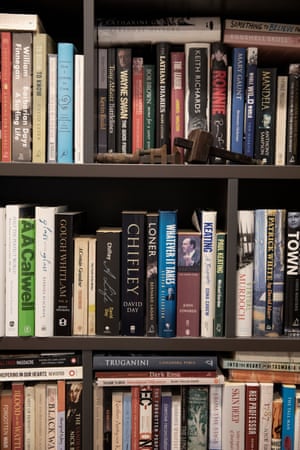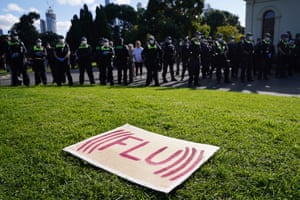I have always worked with facts. I have sifted them for relevance, assembled them to make sense of things, and used them to construct an argument or to disagree with another point of view. Facts are, for journalists, the essential ingredient, like flour for bakers or clay for sculptors. So I recall very clearly how disconcerted I felt when I first sensed they were turning to liquid and sliding through my hands.
It was during Tony Abbott’s campaign against the Labor government’s carbon pricing scheme – the policy he dubbed a “great big tax on everything”. There were, for sure, some factual arguments that could have been deployed against that policy, or alternative ideas that could have been raised. The then opposition leader opted for neither of these methods. Instead, he travelled the country saying things that were patently nonsensical. But most news outlets reported them uncritically, and this firehose of nonsense proved impossible to mop up.

Most days, Abbott would visit a store to make wild claims about price hikes, with only a few journalists, myself included, trailing behind him to unpick them. He went to butcher shops, where worried owners would talk about the looming increase to their power bills. I’d calculate what price rise the butcher would need to pass on that extra cost: less than 0.2%, or 2 cents on a kilo of mince. Since the butcher’s low- and middle-income customers were going to receive compensation from the carbon scheme and would presumably have been able to afford this price increase, the impact on his business would be minimal. But, by then, the nonsense roadshow would have shifted to a supermarket or a pie shop or a pizza shop, where the price of pizza boxes was going to rise by 1 cent a box.
We all know now that the facts never caught up with that “axe the tax” campaign, and that some years later, in a truly breathtaking display of cynicism, Abbott’s chief of staff, Peta Credlin, blithely conceded that they’d always known the carbon price had never been a “tax” at all, and they’d only called it that to stir up “brutal retail politics”.
Despite the inadequate efforts of some of us, the media was a conduit for these “brutal retail politics” throughout that time. For the most part, Australian journalists continued to play by what many considered to be the “rules of the game”, rules that assumed that politicians would stay within the guardrails of truth, save for a bit of spin to spit and polish a campaign, and that journalists would report what each party said, with critiques coming in the “reaction” paragraphs at the bottom of the page.
I always believed that interpretation of the rules to be mistaken. That’s why I was so disconcerted when properly factual reporting was swamped during the carbon pricing “debate”. As the US press discovered even more starkly and consequentially during the 2016 presidential election, those rules just don’t work if the politicians themselves aren’t in any way constrained by facts – if they lie, contradict themselves or simply make things up, or if their calculated tactic is to upend or subvert civic dialogue rather than participate in it.
From that point, the liquefaction of fact-based reporting gained pace. Not content with abandoning the factual norms of public debate, President Donald Trump set about undermining the very concept, popularising the term “fake news” to dismiss anything that made him uncomfortable, and using social media to create a closed loop of alternative “news”, based not on facts but on whatever alternative reality the reality TV king had dreamed up that day, and on demonising the “liberal” media for trying to maintain a fact-grounded public discussion. Facing cost pressures and an audience splintering across the internet’s infinite sources of “news”, outlets like Fox in the US or Sky News (after dark) in Australia built a whole business case on amplifying this populist polarisation and disinformation.

Then came the pandemic, where facts were the most important tool to limit the virus’s spread, as well as the consequential deaths, economic hardship and horrible human suffering. Here, as around the world, readers responded to the pandemic with a seemingly insatiable need for information – the daily briefings; the case numbers; the hospital capacities; long explanations about everything scientists knew about the virus, everything it did to the body, everything epidemiologists could tell us about how it transmits. They wanted maps and graphs and detailed explainers. They wanted instructions about how to make masks and how to home-school and how to cope emotionally. They reached for the best available facts and knowledge as something solid to cling to as our former lives and plans dissolved into uncertainty. Like many news sites, our readership soared and stayed there, dipping and rising slightly like a proxy map for the nation’s fears and anxieties: sky-high in March, down a little in April, May and June and then rocketing back up again in July as the second wave swept through Victoria.
In Australia, our job was made easier because, for the most part, leaders followed expert advice and sidelined the shrill voices urging them to do otherwise. With some exceptions and a few wobbles and disagreements, leaders listened to the health experts and imposed lockdowns and restrictions, brushing aside the few commentators suggesting that things be left open in the interests of economic growth, that elderly Australians would be willing to bear the consequences, that the severity of the whole thing was being exaggerated.
The federal government’s fiscal response has pushed the deficit to a size not seen since the second world war. There is plenty to quibble with in the design and scope of the assistance payments, and even more in the plans for a “gas-led” economic recovery. But in broad terms, despite the obvious contradictions with its own “debt’n’deficit” critique of the Rudd government’s response to the global financial crisis, and some nervousness within its own ranks, economic advice has been heeded.
The enormity of this crisis seems to have shocked Australian politicians out of their reflex to turn to the politics of division, and they have instead sought to respond carefully, sensibly and in ways that might unify the nation. By and large, they have worked cooperatively with one another, and managed nuance and the ability to change tack in line with new evidence. The return of reason has, of course, not been universal. There’s been bickering and tension, and, as the pandemic dragged on, the predictable attempts at buck-passing blame.

And it turns out that old-fashioned evidence-based governing is an effective way to respond to a pandemic.
In the US – where Trump has ignored warnings, sidelined public health experts, insisted the disease will just disappear “like a miracle” and spread innumerable falsehoods and conspiracy theories – the mortality rate, as measured as deaths per 100,000 citizens, stood at 54.18 at the time of writing. (Although, in an interview with Axios’s Jonathan Swan, the president himself did not seem to understand these figures). In the UK, where the prime minister, Boris Johnson, began by boasting that he had shaken hands with everyone in a Covid-19 ward before changing tack after being hospitalised with the disease himself, the rate was 62.4.
In Australia, where state and federal leaders have cooperated, followed advice, held every press conference alongside public health officials who have themselves now become trusted public figures, and have for the most part followed expert advice, the rate was 2.1. In New Zealand it stood at 0.45.
As well as being a better method of dealing with the most immediate challenge of our lifetimes, self-interest may also motivate politicians to maintain this change, because, it also turns out, voters like it. By August Scott Morrison’s handling of the crisis was approved by more than 60% of Australians, and the approval ratings for state premiers were similar. Victoria’s premier, Dan Andrews, has been under sustained attack from sections of the press for his state’s mistakes in an onslaught far more fierce than that faced by any other leader. But despite this, and even as he sought to manage Australia’s first stage-four lockdown and the country’s worst transmission rates, his approval ratings remained at about 50%.
And when the political debate stays within the broad parameters of sensible discourse and reasonable disagreement, it is far easier to report and interrogate. Australia’s media didn’t have to explain why the leader of the country was wrong to suggest that the virus could be cured by injecting bleach, or decipher daily contradictions and incoherence.
Sure, Australia has its anti-maskers and “sovereign citizens” and anti-vaxxers and various other people who see some kind of conspiracy behind the roll-out of 5G but the overwhelming response from journalists, politicians and public health experts is to condemn them as dangerous cranks. Conservative columnists can exercise their right to fulminate about how compulsory mask-wearing is “virus hysteria” and others can describe lockdowns as tantamount to “dictatorship” but the vast majority of Australians are politely declining to engage in this particular culture war in the interests of getting on with following expert advice and fighting the spread of the disease.

Early evidence suggests this calmer public discourse has enhanced people’s trust in the Australian media, and that, unlike in the US, where the idea of news has been politicised, there isn’t a huge partisan difference in the extent to which Australians trust the news.
Could it be that expertise is making a comeback? Could it be that we are able to create a virtuous cycle of politicians being rewarded for dialling down hyper-partisanship, and the media rewarded for a somewhat calmer tone to reporting and analysis? Dare we hope that facts might be solidifying again as the sensible, common-ground foundation for civic debate?
There are increasing problems alongside these possibilities: the pre-Covid pressures on the media business model are only accelerating, and the global, mostly unregulated, “open mic” of the internet continues to present news, and credible citizen commentary and views, alongside outright lies and disinformation as if they are equally credible.
To regain our footing, news organisations need to be clear about what has gone wrong, what we are doing right, and what those “rules of the game” should have been in the first place.
Some in the media are now arguing that the problem lies with the very idea that we should aim for objectivity, that this goal has created a system that allows a select group to determine what “objective truth” means, or has created a formula that blindly defines “neutrality” as the midpoint in a discussion, even when one side is resorting to lies and misinformation. Those are valid criticisms – of the lack of diversity in newsrooms, and of what some journalists do – but in my view they completely misunderstand what journalistic objectivity is supposed to mean.

Journalism is not stenography. It was never supposed to involve unthinkingly transcribing whatever nonsense a political leader might spout about the price of meat or takeaway pizzas without making an assessment of those claims. It was never about a reflexive positioning midway between the views of opposing parties. If someone is demonstrably lying, or talking through their hat, then that is what we should say. As Alan Sunderland, the journalist and former ABC executive, wrote in Meanjin in response to such arguments, “regurgitating the views of others without assessing their factual basis is not journalism. Balancing a smart well-informed view with an ignorant ill-informed view and giving them the same weight is not journalism. Failing to care about where the truth lies is not journalism.”
Sunderland expressed a “great fear”, which I share, that “deciding that modern journalism is not doing its job properly, the solution will be encouraging it to move away from notions of impartiality and towards being a partisan player in the game, instead of recommitting itself to the clear-headed and powerful role it has always needed to play as an honest broker for the facts”.
An even more powerful exposition of this issue came from Tom Rosenstiel – who, along with Bill Kovach, wrote the text The Elements of Journalism – in a long Twitter thread responding to a powerful essay in the New York Times by the Pulitzer-prize winning reporter Wesley Lowery. I recommend the whole thread but I’ll summarise it here.
Rosenstiel argues that objectivity was never meant to devolve to “he said/she said” journalism but rather required journalists to employ objective, observable, repeatable methods of verification, precisely because they could never be personally objective.
“I fear a new misunderstanding is taking root in newsrooms today, one that could destroy the already weakened system of journalism on which democracy depends,” he tweeted.
“That misunderstanding is the idea that if we adopt subjectivity to replace a misunderstood concept of objectivity, we will have magically arrived at truth – that anything I am passionate about and believe deeply is a kind of real truth.

“If journalists replace a flawed understanding of objectivity by taking refuge in subjectivity and think their opinions have more moral integrity than genuine inquiry, journalism will be lost.
“If we mistake subjectivity for truth, we will have wounded an already weakened profession at a critical time. If we lose the ability to understand other points of view we will have allowed our passions to overwhelm the purpose democratic society requires of its press.”
Or, to put it the other way round, if we plant our feet firmly on the foundational idea that we follow the facts wherever they lead, we could strengthen our profession at this critical time, when democratic society desperately needs it.
Misinformation and dangerous conspiracy theories thrive when people are uncertain and stressed and alone – exactly the conditions created by this disease, which requires us to isolate from one another to survive. As Wade Davis wrote in Rolling Stone, “pandemics and plagues have a way of shifting the course of history”.
When we are finally able to resume our lives, information and considered debate could chart our post-pandemic course for the better. We might manage to reinstate facts to our consideration of climate policy and abandon the notion that caring about the future of the planet is a partisan issue, or something to be exploited in the interests of short-term “brutal retail politics”. If we call out lies, are curious and open-minded to different points of view and ideas, can return to politics as reasonable means of brokering differing views, and can brace ourselves against those who would turn everything into some kind of “war”, we might help nurse civic debate back to something constructive, as we try to recover and rebuild.
Perhaps, just perhaps, the way we handled the early stages of the pandemic has proved that this is possible.
o This essay will be part of the anthology Fire, Flood and Plague, edited by Sophie Cunningham and published by Penguin Random House in December